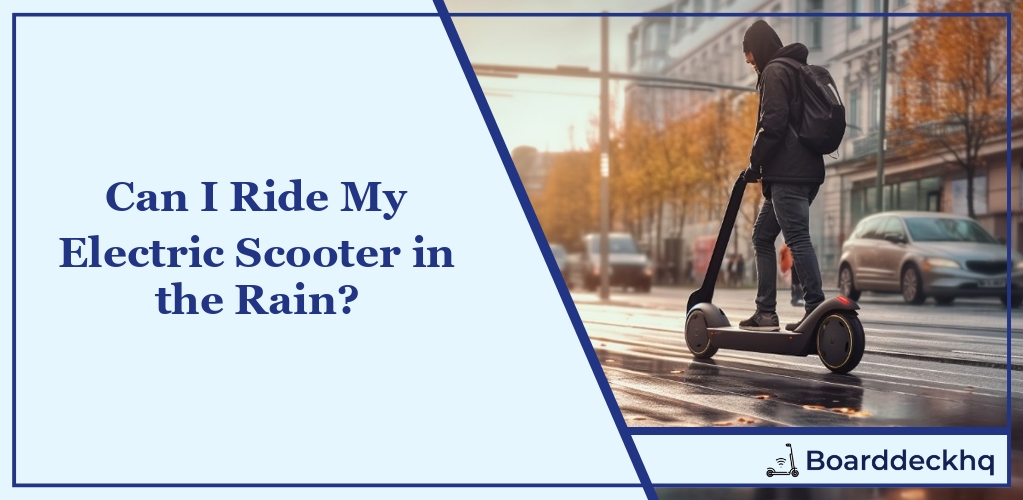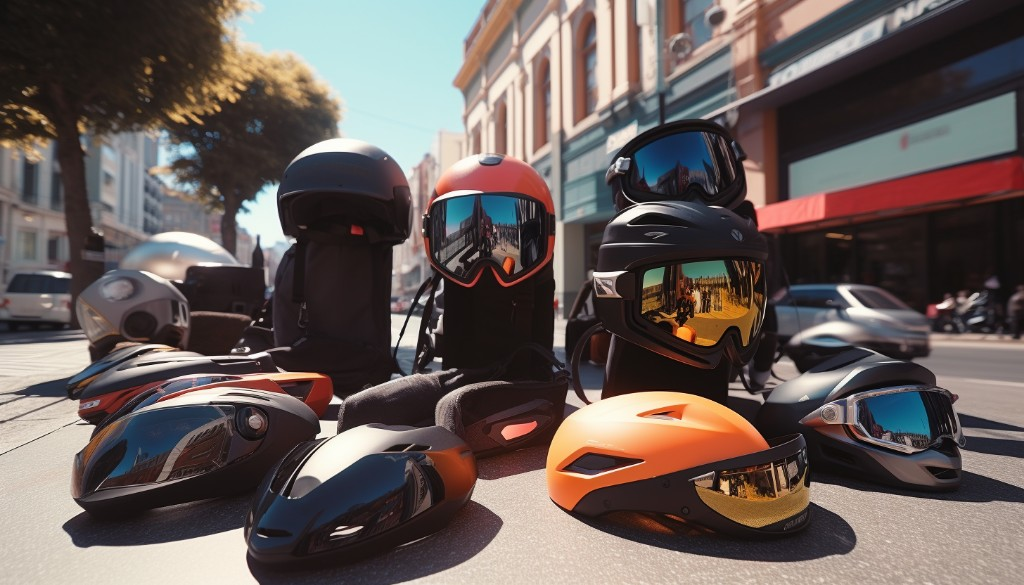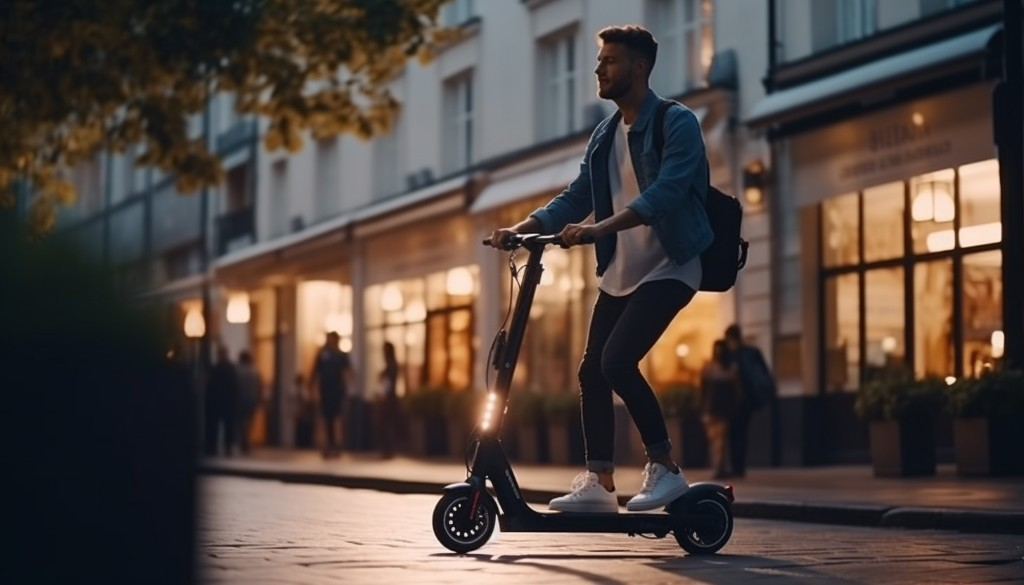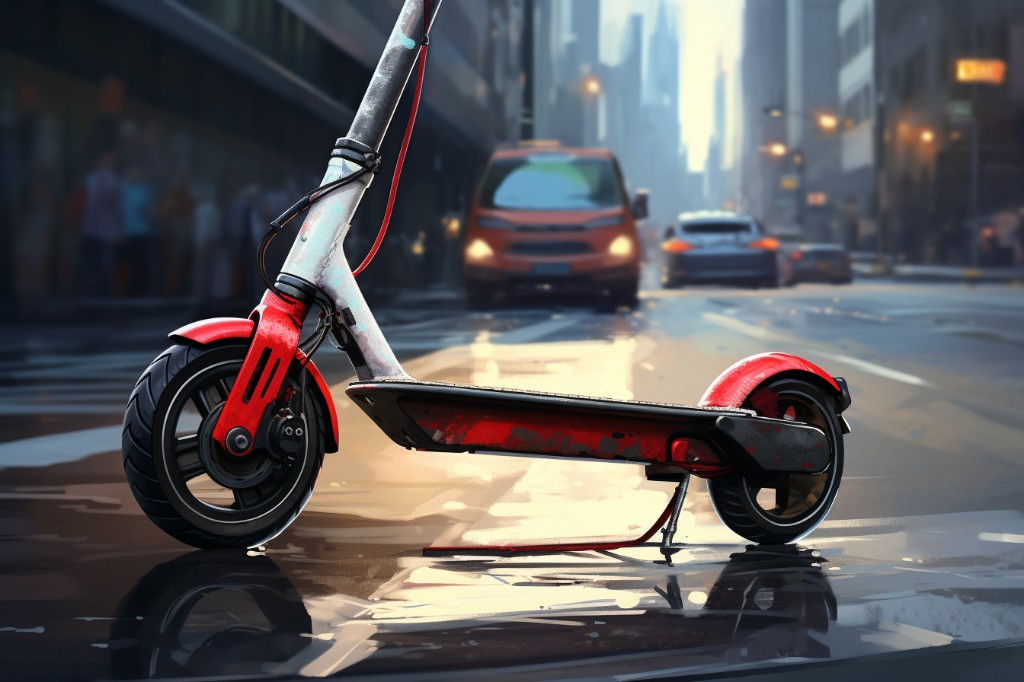Ever zipped through the city on your electric scooter and found yourself caught in a sudden downpour? As raindrops start hitting your face, you’re likely left wondering, “Can I ride my E-Scooter in the rain?” While electric scooters offer a convenient and eco-friendly mode of transportation, their compatibility with wet weather isn’t always clear-cut. This article will unveil the mysteries surrounding this topic, making your rainy rides safer and more enjoyable.
What we’ll cover:
- E-Scooter Water Resistance
- The Role of IP Ratings
- Rainy Riding Safety Measures
- Wet Weather and Scooter Laws
- E-Scooter Maintenance and Care
So buckle up and put on your raincoat! We’re about to dive into the world of wet weather electric scooting, proving that a little rain shouldn’t stop your ride.
Understanding E-Scooter Water Resistance
When it comes to using your electric scooter in the rain, a key factor to consider is the water resistance of your E-Scooter. Now, when we say “water-resistant,” it’s not quite the same as saying your scooter is waterproof.
Imagine you’re out for a picnic and you’ve packed a sandwich in a plastic bag. A water-resistant bag might keep your sandwich dry if you accidentally drop it in a puddle, but a waterproof bag could be submerged in a lake and still keep your lunch edible.
The same concept applies to electric scooters. Many manufacturers claim their electric scooters are water-resistant, which means they can handle light rain or a small splash of water. But if you’re thinking of going for a ride in a heavy downpour or across deep puddles, that’s where you might run into trouble.
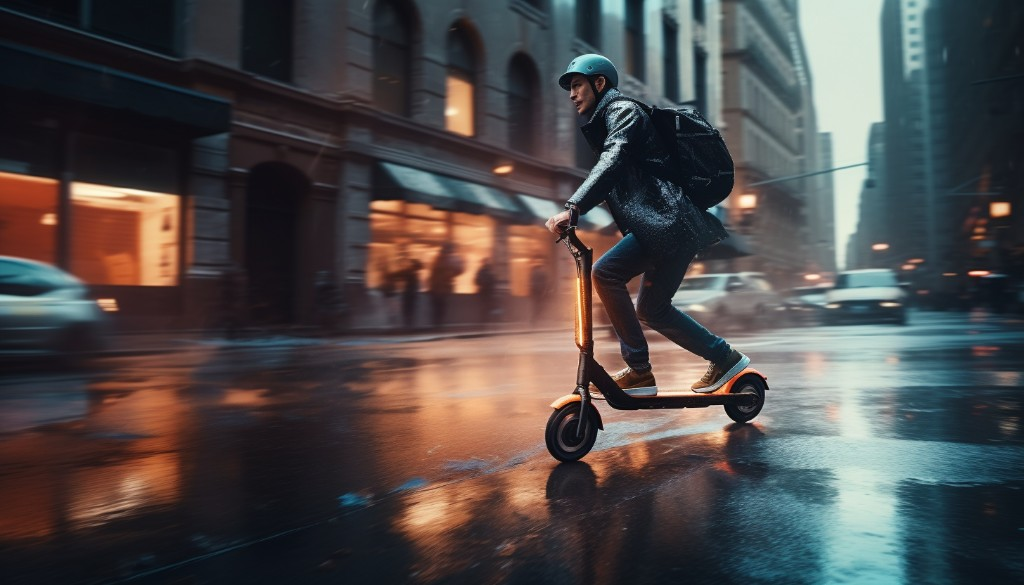
The reality is that most electric scooters are not designed to be completely waterproof. Prolonged exposure to water can cause damage to the scooter’s components, particularly the electrical parts. The battery, motor, and control board are particularly susceptible to water damage.
This is why it’s essential to understand the difference between what manufacturers claim about their scooters’ water resistance and the real-world scenarios you might encounter when riding your electric scooter in the rain.
How Rain Affects Your Electric Scooter’s Performance
Now that we’ve established that riding an electric scooter in wet conditions can potentially damage its components, let’s delve into how the rain can affect your E-Scooter’s performance.
Firstly, handling. Wet surfaces can make your electric scooter’s tires lose grip, making it more challenging to maintain control while riding. This could lead to potential accidents, particularly if you need to make sudden turns or stops.
Next, we have battery life. Water and electricity don’t mix well, and exposure to rain can cause the battery to drain faster than usual. This could potentially leave you stranded mid-journey with an E-Scooter that’s out of juice.
Finally, let’s talk about rider safety. Riding in wet conditions not only affects the scooter but also poses risks to the rider. Wet surfaces can cause slips and falls, and visibility is often reduced in rainy weather, making it harder for others to see you, and for you to see potential hazards.
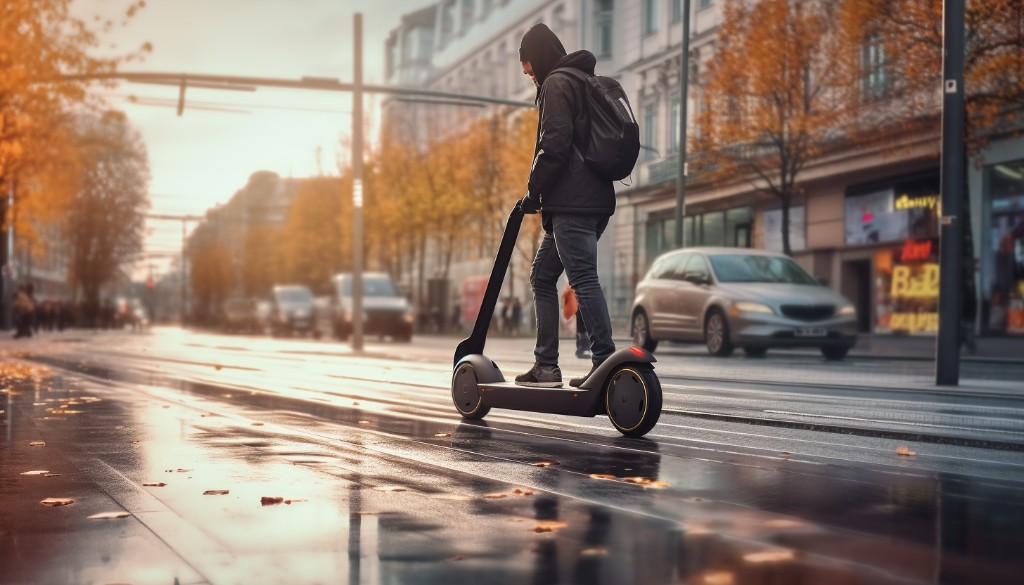
Risks and Dangers of Riding in the Rain
Beyond the impact on your electric scooter’s performance, there are several risks associated with riding in the rain. Slippery surfaces are a significant concern. When it rains, roads and sidewalks can become slick, especially if there’s oil or other substances present. This can make braking more challenging and increases the risk of sliding or falling off your electric scooter.
Reduced visibility is another factor to consider. Rain can make it harder for you to see and for others to see you. This can be particularly dangerous when sharing the road with cars and other vehicles.
Lastly, there’s the potential for electric shock. While rare, riding an electric scooter in heavy rain can lead to short circuits, which could potentially give the rider an electric shock. While most modern E-Scooters have safety measures in place to prevent this, it’s still a risk worth considering.
Understanding these risks can help you make an informed decision about when and where to ride your electric scooter. However, there’s one more thing you need to know about: IP ratings. These ratings provide more specific information about how water-resistant your E-Scooter actually is…
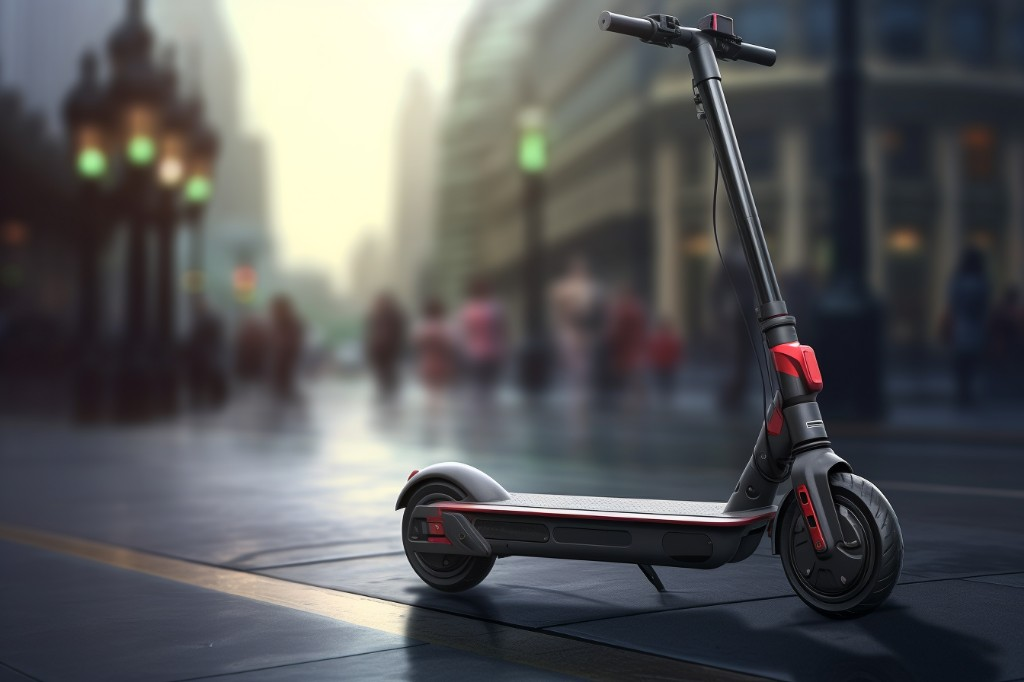
IP Ratings and Their Importance
Picture this: you’re cruising down the street on your electric scooter, headphones in, wind in your hair, when suddenly, the heavens open up. Rain pours down. You’re stuck in the middle of the road with a piece of technology that might not handle water well. If you’ve ever found yourself in such a situation, you know how important it is to understand your E-Scooter’s IP rating.
IP ratings, short for Ingress Protection ratings, are an international standard that specifies the degree of protection an electronic device has against intrusion from foreign bodies, including dust and water. These ratings are paramount for determining how well your electric scooter can withstand exposure to water or dust.
Essentially, an IP rating will tell you whether your E-Scooter can handle a light drizzle or if it’s robust enough to withstand water jets from any direction. It’ll also clue you in on whether the internals of your electric scooter are protected from dust.
Decoding IP Ratings for E-Scooters
The IP rating system consists of two digits. The first digit, ranging from 0-6, signifies the level of protection against solid objects and dust, with 6 being the highest level of protection. The second digit, ranging from 0-8, indicates the level of protection against water ingress, with 8 offering the highest level of protection.
For instance, an E-Scooter with an IP rating of IP54 would have a dust protection level of 5 and a water protection level of 4. This means it’s protected against dust ingress sufficient to prevent equipment damage and can withstand water splashes from any direction.
However, if you’re a heavy user who often rides in rain, you might want to consider an electric scooter with a higher water protection level. A scooter with an IP rating of IP65, for instance, is not only dust protected but can also withstand low-pressure water jets from any direction. A rating of IP66 or above would mean the scooter can even withstand high-pressure water jets.
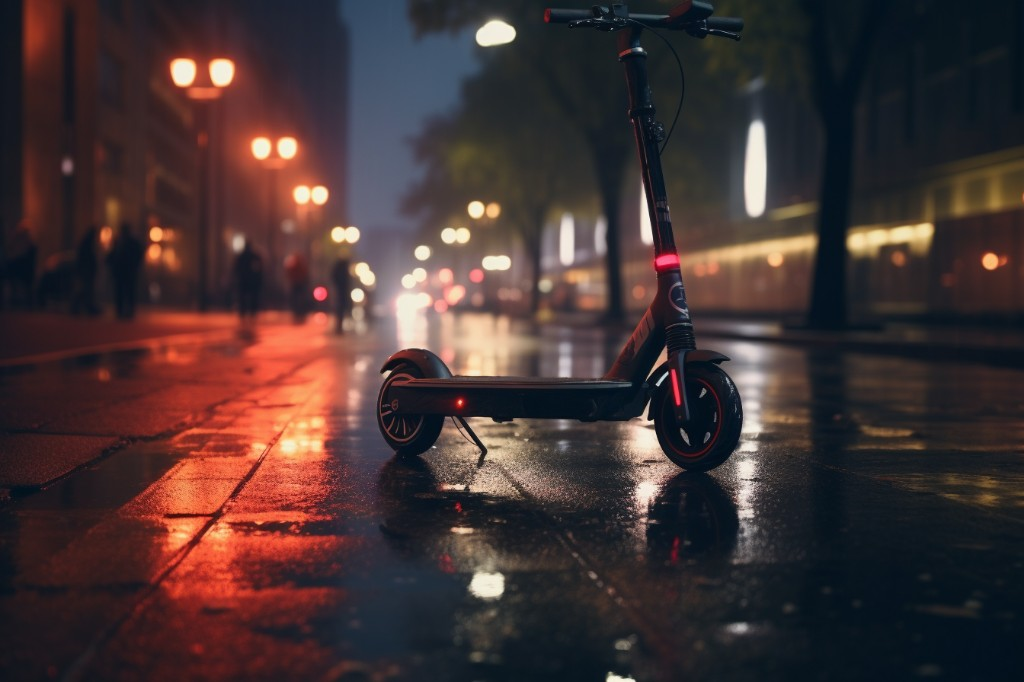
Selecting the Right E-Scooter Based on IP Ratings
Now that you’re familiar with what IP ratings mean, it’s time to select the right electric scooter based on these ratings and your local weather conditions.
If you live in a region where rain is frequent and heavy, opting for an E-Scooter with a high IP rating is crucial. An IP65 or higher would be a safe bet in this case. Remember, it’s not just about being able to ride in the rain; it’s also about ensuring your electric scooter’s longevity and avoiding potential electrical issues that can arise from water ingress.
However, if you reside in a region with minimal rainfall, an electric escooter with an IP54 or IP55 rating would suffice. These scooters can handle light rain and occasional water splashes.
Also, consider how much dust exposure your electric scooter might face. If you’re planning to ride on unpaved roads or in dusty conditions, an E-Scooter with a high first digit in the IP rating would be beneficial.
In essence, understanding IP ratings and selecting the right E-Scooter based on these ratings is crucial to ensure you get the most out of your scooter, regardless of the weather conditions.
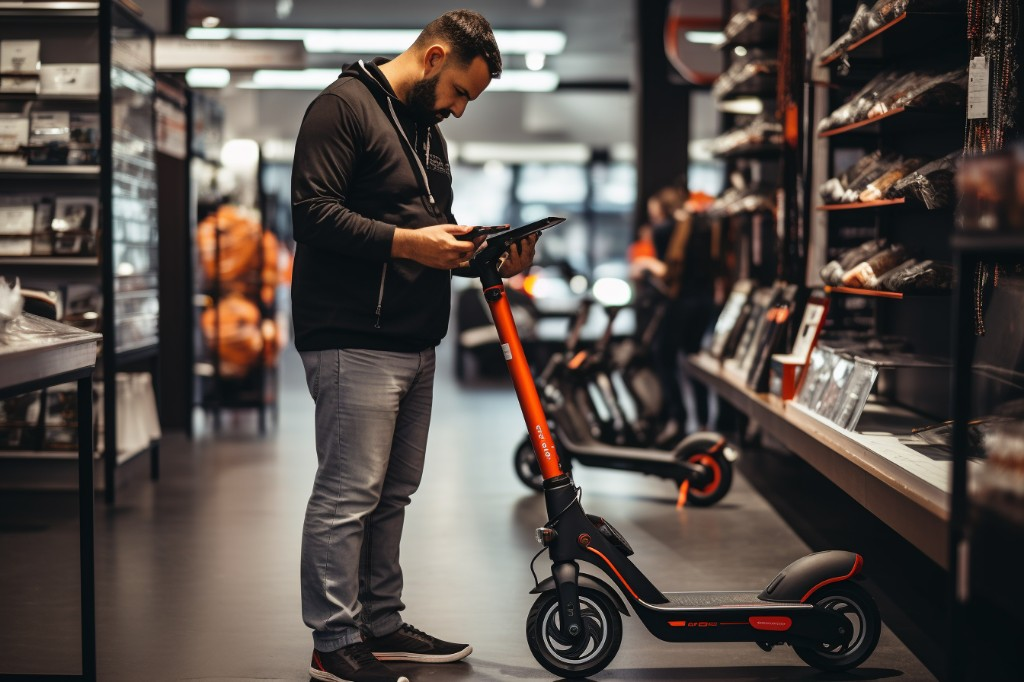
Safety Measures for Riding in the Rain
Riding an electric scooter in the rain isn’t much different from a sunny day scoot, but it does require some extra precautions. Safety measures are essential to ensure a smooth ride and to prevent accidents. After all, just like a slick movie hero can slide on a banana peel, so too can your electric scooter on a wet pavement!
Appropriate Gear
Dressing for the occasion isn’t just about looking good, it’s also about staying safe. When you’re riding your electric scooter in the rain, proper rain gear is key. This includes waterproof jackets, pants, and shoes to keep you dry. Don’t forget a helmet with a visor to protect your head and provide clear vision. Gloves with a good grip are also essential, as they prevent your hands from slipping off the handlebars.
Riding Techniques
As for riding techniques, slower is safer when it comes to wet surfaces. Rain can make roads slippery, so be sure to reduce your speed and take turns with extra caution. Just like an experienced captain slows his ship in turbulent waters, you too should ease off the throttle in the rain. Also, try to avoid puddles as they can hide potholes or other road hazards. Riding in a straight line and avoiding sudden movements is also advisable.
Precautions to Take When Riding Your E-Scooter in the Rain
Taking precautions before, during, and after riding your electric scooter in the rain is as essential as carrying an umbrella during a downpour.
Before Riding
Before setting out, it’s wise to check weather forecasts. If heavy rain or storms are expected, it might be better to postpone your ride. Also, ensure your electric scooter is in good condition. Check the brakes, lights, and tire pressure – think of it as a pre-flight checklist for your ground-level journey.
During Riding
While riding, stay alert for potential hazards like slippery surfaces, puddles, or debris. Keep a safe distance from other vehicles, and use your lights to ensure you’re visible to others. Remember, just like a lighthouse guides ships through the fog, your electric scooter’s lights will guide you safely through the rain.
After Riding
Post-ride, it’s crucial to perform scooter maintenance. Wipe down your E-Scooter to remove any water or dirt. Check for any damage and make sure all parts are functioning properly. This is akin to a farmer tending to his tools after a long day in the fields – it’s all about prolonging the life and functionality of your ride.
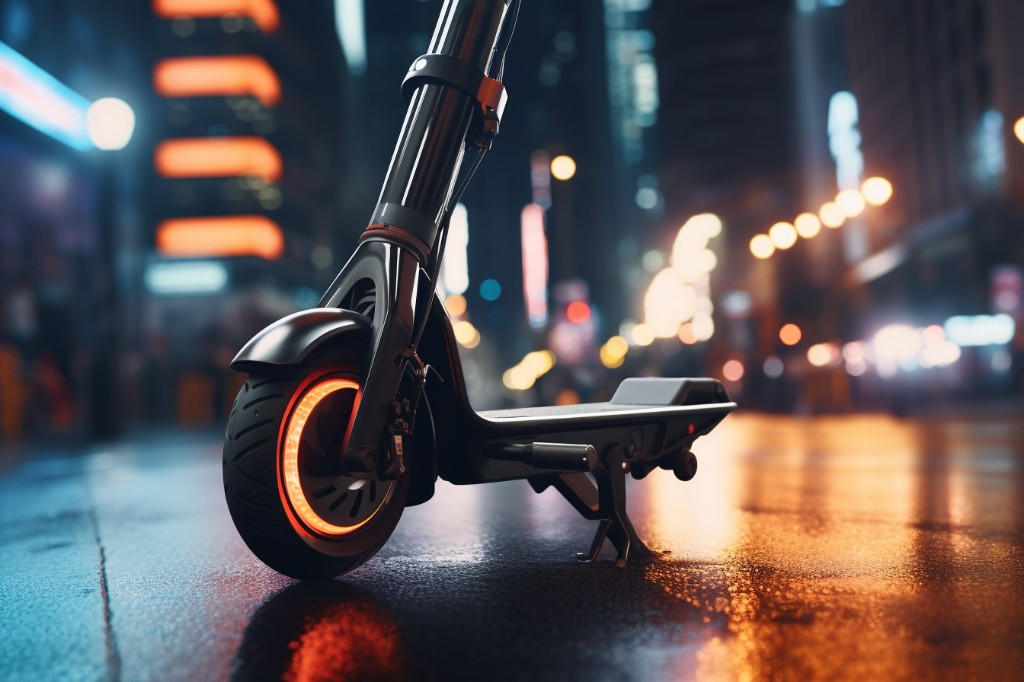
Do’s and Don’ts of Wet Weather Scooting
Just as there are rules of the road, there are also do’s and don’ts for wet weather electric scooting.
Do’s
- Do reduce your electric scooter speed in the rain.
- Do wear appropriate gear, including waterproof clothing and a helmet.
- Do use your lights to increase visibility.
- Do perform regular electric scooter maintenance.
Don’ts
- Don’t ride through deep puddles or on excessively slippery surfaces.
- Don’t make sudden movements or sharp turns.
- Don’t ignore weather forecasts and warnings.
- Don’t neglect your E-Scooter’s maintenance after a rainy ride.
Remember, taking these precautions can make the difference between a safe, enjoyable ride and an unfortunate accident.
Riding your E-Scooter in the rain doesn’t have to be a daunting task. With the right safety measures, precautions, and understanding of wet weather scooting, you can confidently ride through those raindrops. Now, let’s dive into how electric scooter laws may impact your rainy day rides.

Electric Scooter Laws and Wet Weather
Ever wondered if there are any specific electric scooter laws for wet weather? Well, you’re not alone. The answer to this question varies from region-to-region. Some cities have specific regulations that prohibit the use of electric scooters during inclement weather, while others leave it to the discretion of the rider.
In many areas, such as San Francisco, the law doesn’t explicitly ban riding E-Scooters in the rain. However, it does emphasize on safety measures and encourages riders to avoid adverse weather conditions whenever possible. It’s like being allowed to eat ice cream for breakfast – just because you can, doesn’t mean you should!
Weather Restrictions in Different Regions
In some parts of Europe, for instance, there are strict regulations against riding electric scooters during heavy rain or snow. These laws stem from the potential safety risks posed by slippery surfaces and reduced visibility. It’s comparable to not being allowed to drive with bald tires – it’s all about ensuring safety.
Understanding Local Regulations
Before you venture out on your electric scooter in wet weather, it’s crucial to familiarize yourself with local regulations. Just like you’d check the dress code before attending a party, it’s good manners (and often mandatory) to understand and respect the rules of the road.
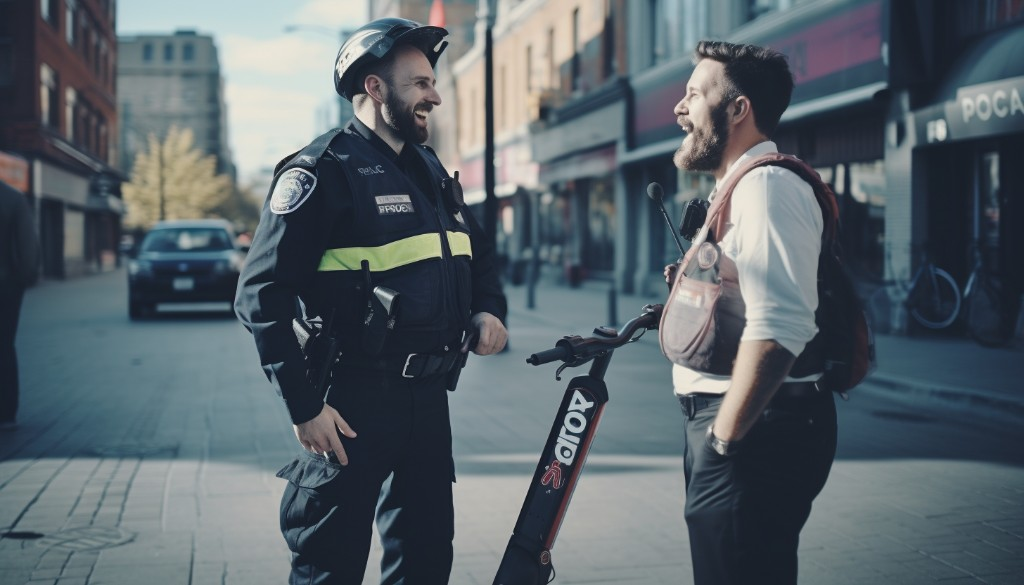
How Weather Conditions Affect E-Scooter Use
Changing weather conditions can drastically affect electric scooter use, much like how a sudden rainstorm can ruin a picnic. During rainy weather, not only does the risk of accidents increase due to slippery surfaces, but also the E-Scooter’s performance can take a hit.
Impact on Battery Performance
Cold and wet weather conditions can significantly impact the battery life of your electric scooter. It’s similar to how our energy levels dip when we’re cold – the same applies to your E-Scooter’s battery.
Safety Concerns
Apart from technical issues, riding an electric scooter in the rain can be a safety hazard. Reduced visibility, slippery surfaces, and unpredictable movements of pedestrians and vehicles add up to make a challenging environment for E-Scooter riders. It’s like trying to navigate a maze blindfolded – not a situation you’d want to find yourself in.
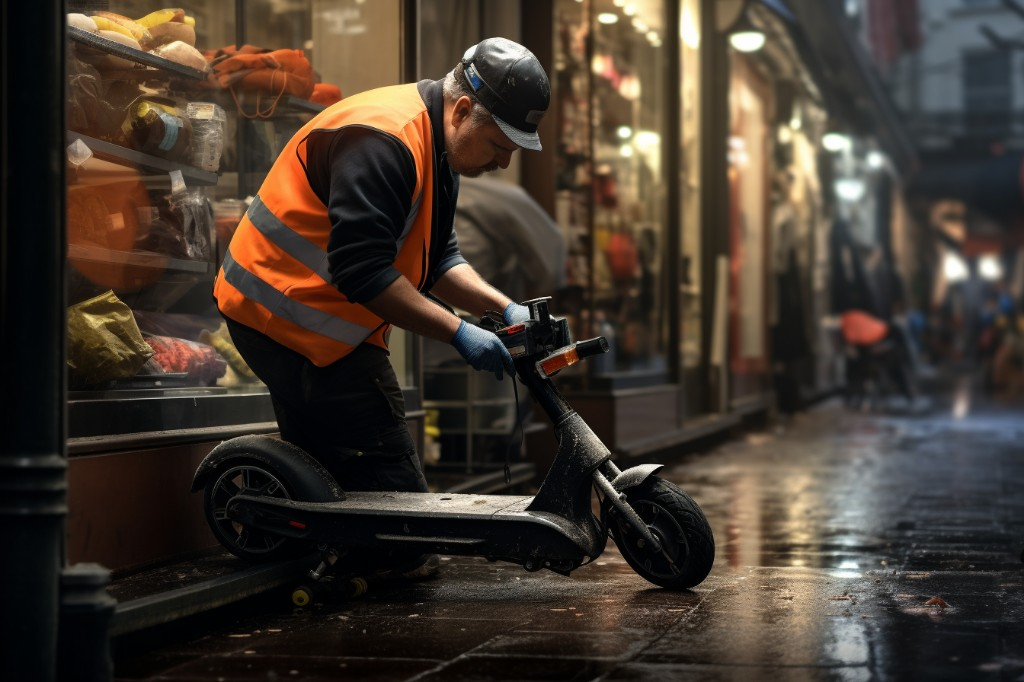
Riding Your E-Scooter in the Rain: What the Law Says
When it comes to laws about riding an electric scooter in the rain, there’s no one-size-fits-all answer. The rules vary from city to city, and country to country.
In some places like Toronto, Canada, for example, there are no specific laws against riding electric escooters in the rain. However, riders are advised to exercise caution and prioritize safety over convenience. It’s like being told to slow down when driving on a wet road – the aim is to prevent accidents.
Penalties for Non-Compliance
Non-compliance with electric scooter laws can lead to hefty fines or even impounding of the E-Scooter in some regions. Some cities have implemented strict penalties for riders caught using E-Scooters in prohibited weather conditions or failing to follow safety regulations. So it’s crucial to stay updated with local electric scooter laws and adhere to them.
The Importance of Safety
Regardless of what the law says, it’s important to remember that safety should always be your top priority when riding your electric scooter, especially in adverse weather conditions. It’s like wearing a seatbelt in a car – it’s not just about following the law; it’s about protecting yourself.
In the end, even though riding your E-Scooter in the rain might seem like an exciting adventure, it’s essential to consider the potential risks and legal implications. So before you step out, make sure you’ve checked the weather forecast, your local laws, and of course, don’t forget your raincoat!
Maintenance and Care for Your E-Scooter
I like to think of my E-Scooter as a trusty steed. Just as a horse needs grooming and care, your electric scooter also requires regular maintenance, particularly after being exposed to wet conditions. Regular care not only prolongs the lifespan of your E-Scooter but also ensures optimal performance.
The Importance of Regular Maintenance
Imagine this: you’re about to leave for work, but your electric scooter refuses to start. It’s the last thing you need on a Monday morning. To avoid such scenarios, consistent electric scooter maintenance is essential. Wet conditions, especially, can be harsh on your E-Scooter’s components, accelerating wear and tear.
Tips for Proper Care
Here are a few tips for taking care of your e-scooter:
- Keep it Clean: After riding in the rain, make sure to wipe down your e-scooter and remove any dirt or debris that might have lodged in small crevices.
- Check the Brakes: Wet conditions can affect the braking system. Ensure that the brakes are working properly before your next ride.
- Inspect the Tires: Rain can make roads slippery, putting extra strain on your tires. Regularly check them for any signs of wear.

Protecting Your E-Scooter’s Battery from Rain Damage
Your electric scooter’s battery is its lifeblood, powering every journey you take. Protecting it from rain damage is crucial to ensure its longevity.
Why Battery Protection Matters
Rainwater, if allowed to seep into the battery compartment, can cause corrosion and reduce battery efficiency. In severe cases, it can even cause the battery to fail completely.
Tips for Battery Care
Here are some ways to shield your battery from rain damage:
- Waterproof Case: Consider investing in a waterproof case for your electric scooter’s battery. This will provide an extra layer of protection against rainwater.
- Avoid Deep Puddles: Try to avoid riding through deep puddles as this can increase the risk of water entering the battery compartment.
- Regular Checks: After riding in the rain, check the battery compartment for any signs of water ingress.
How to Dry Your E-Scooter After Riding in the Rain
After a rainy ride, it’s essential to dry your E-Scooter properly to prevent water ingress and potential damage. This process might seem daunting, but with a step-by-step guide, you can do it with ease.
Steps to Dry Your E-Scooter
- Turn off Your E-Scooter: Before you start, make sure your E-Scooter is turned off and unplugged.
- Remove Excess Water: Wipe down your E-Scooter with a dry towel to remove any visible water droplets.
- Focus on Key Areas: Pay special attention to areas like the battery compartment, motor, and control panel where water ingress could cause significant damage.
- Leave it to Dry: If possible, leave your E-Scooter in a dry, well-ventilated area to dry off naturally.
- Check for Damage: Once your E-Scooter is dry, check it over for any signs of water damage or corrosion.
So, can you ride an electric scooter in the rain? Absolutely! But remember, taking care of your E-Scooter post-ride is just as important as the ride itself. By following these maintenance and care tips, you can ensure that your electric scooter stays in top shape, rain or shine.
Closing Thoughts
Riding an electric scooter in the rain is a topic that demands attention to a variety of factors, including understanding the water resistance of your E-Scooter, being aware of the IP ratings and their significance, and taking appropriate safety measures. It also necessitates comprehension of local electric scooter laws related to wet weather conditions. Maintenance and care for your E-Scooter is another crucial aspect that cannot be overlooked, especially when it comes to protecting the battery from rain damage and drying the E-Scooter post-rain ride. Understanding how to ride an electric scooter safely in the rain can help foster safe and responsible use of these popular modes of transportation, regardless of the weather.
Frequently Asked Questions
Is it safe to ride my E-Scooter in the rain?
Yes, it can be safe to ride your electric scooter in the rain provided you take necessary precautions. Always ensure your E-Scooter is rated for water resistance and remember that wet surfaces can make braking and maneuvering more challenging.
Can my E-Scooter handle rain?
This depends on your E-Scooter’s IP rating. An IP rating is a standard that defines the levels of sealing effectiveness against intrusion from foreign bodies (tools, dirt, etc) and moisture. Check your electric scooter’s user manual or product specifications to find out its IP rating.
What precautions should I take when riding my E-Scooter in the rain?
When riding your electric scooter in the rain, make sure you wear appropriate gear like a waterproof jacket and non-slip shoes. Be extra cautious on wet surfaces, avoid puddles, and always brake earlier than you normally would to account for potential sliding.
Do E-Scooters work in the rain?
Most modern electric scooters are designed to handle light to moderate rain. However, it’s not recommended to ride in heavy rain or to leave your E-Scooter out in the rain, as this could potentially damage the battery and other electrical components.
What happens if my E-Scooter gets wet while riding in the rain?
If your E-Scooter gets wet while riding in the rain, it’s important to dry it off as soon as possible. Water can damage the battery and other electrical parts, especially if it gets inside the scooter. After riding in the rain, wipe down your electric scooter thoroughly and store it in a dry place.
